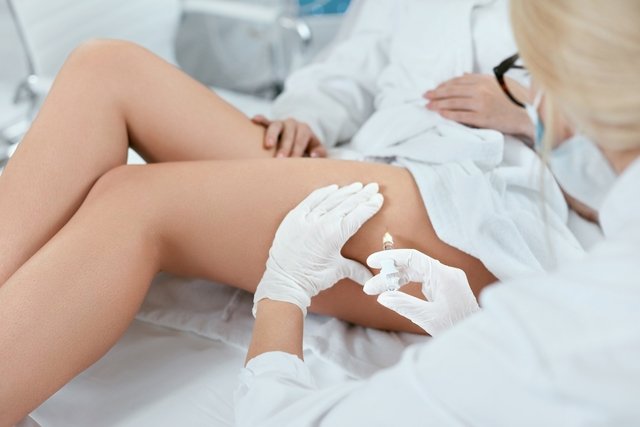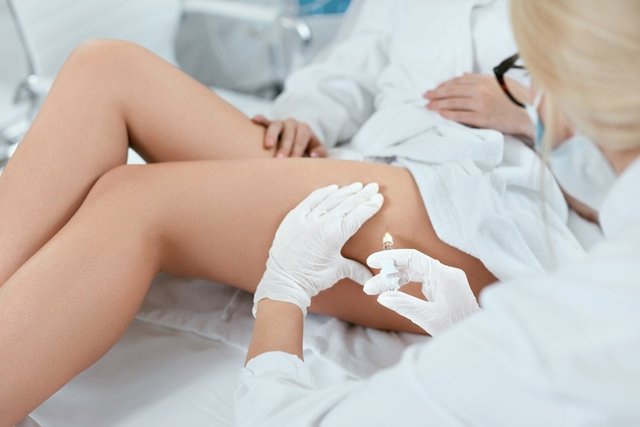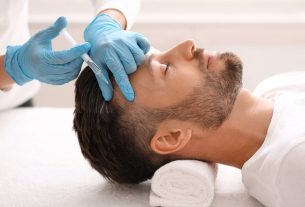The application of enzymes is an aesthetic treatment indicated for the loss of fat located on the belly, culottes, back, arms or inner thighs, as well as double chin, weight loss, sagging, or cellulite.
This treatment is carried out by applying enzymes under the skin, which break down fat cells or stimulate collagen production, making it an aesthetic treatment option for women or men who want to improve their appearance and body contour without surgery.
There are different types of enzymes, which vary according to the objective of the treatment, and must be applied by a dermatologist or a professional specializing in aesthetics.

What is it for
The application of enzymes is indicated for:
- Eliminate fat located on the belly, buttocks, back, inner thigh, arms or below the buttocks;
- Help with weight loss;
- Reduce cellulite;
- Reduce double chin;
- Reduce sagging and wrinkles in the skin;
- baldness
The application of enzymes must be carried out by a dermatologist or beautician, and different enzymes can be applied according to the objective of the treatment, on an individual basis.
Taking care of your health has never been easier!
When is it indicated
The application of enzymes is recommended for women or men who wish to lose localized fat or lose weight, and improve their body contour and appearance without the need for surgery.
Furthermore, it is recommended for people who want to reduce cellulite, rejuvenate their skin or treat hair loss.
How it works
Enzymes applied under the skin work in different ways, which include:
- Promote the breakdown of fat;
- Stimulate metabolism;
- Improve local blood circulation;
- Hydrate the skin and stimulate collagen production;
- Reduce skin swelling, improving the appearance of cellulite;
- Promote decreased appetite;
- Stimulate the growth of new hair strands.
Depending on the objective of the treatment, the doctor or beautician may recommend the application of different enzymes, such as lyase, lipase, hyaluronidase, collagenase or deoxycholic acid, or a cocktail of enzymes, for example.
How it is made
The application of enzymes is done through intradermal or subcutaneous injections, with a fine needle, applied under the skin, in the region to be treated.
Furthermore, in the case of applying enzymes to reduce appetite, the application is done intramuscularly, that is, in the gluteal muscle.
Before applying the enzymes, the doctor or beautician cleans the skin with 70% alcohol or other antiseptic products to avoid infections at the injection site.
Then, the region to be treated is marked with a pencil and the enzymes are applied.
Generally, applying enzymes under the skin lasts about 30 minutes. In the case of application to the muscle, it is faster, lasting around 5 to 10 minutes, as 1 application is made to each glute, and the person can now go home.
How many sessions are needed?
The number of enzyme application sessions varies according to the treatment to be carried out.
For localized fat, 5 to 10 sessions are generally recommended, with intervals of 1 to 2 weeks between applications.
How to enhance the application of enzymes?
To enhance the results of applying enzymes for localized fat, cellulite, flaccidity or weight loss, it is important to maintain a balanced diet, drink around 2 liters of water per day, in addition to exercising regularly.
Furthermore, it is important to lightly massage the treated region or perform lymphatic drainage for at least a week after the session, to improve blood and lymphatic circulation in the area, reducing swelling. See how to do lymphatic drainage at home.
Other aesthetic treatments, such as cryolipolysis, radiofrequency or carboxytherapy can also help to enhance the results of applying enzymes.
Care after application
Some precautions are important after applying enzymes, such as:
- Apply sunscreen daily, with SPF 30 or more, on the treated area, reapplying whenever necessary;
- Avoid taking anti-inflammatory medications;
- Avoid using a swimming pool, bathtub or sauna.
Furthermore, it may be recommended by your doctor or beautician to reduce physical exercise for at least 48 hours after the procedure.
Risks of applying enzymes
The application of enzymes is considered a safe aesthetic procedure when carried out by a dermatologist or a professional specializing in aesthetics, evaluating the person’s health conditions before the procedure.
However, as it is a procedure performed using enzymes, swelling, pain, redness or bruising may occur, which generally lasts 1 to 2 days.
In addition, infections or nodule formation may occur in the treated region, which must be reported to the doctor for evaluation and guidance.
Who shouldn’t do
The application of enzymes should not be done on children, pregnant or breastfeeding women, or by people who have infections, high blood pressure or allergies to the enzymes used or to seafood.
Furthermore, the application of enzymes should not be used in people who have heart, kidney or liver problems, cardiovascular diseases, diseases that affect the immune system such as AIDS or lupus, for example.
The application of enzymes should also not be used in people being treated with anticoagulant medications, due to the greater risk of bleeding.

Sign up for our newsletter and stay up to date with exclusive news
that can transform your routine!
Warning: Undefined array key "title" in /home/storelat/public_html/wp-content/plugins/link-whisper-premium/templates/frontend/related-posts.php on line 12
Warning: Undefined array key "title_tag" in /home/storelat/public_html/wp-content/plugins/link-whisper-premium/templates/frontend/related-posts.php on line 13




